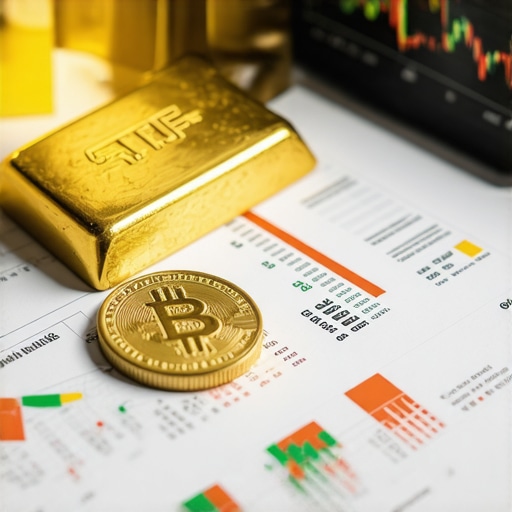Unveiling the Future: Strategic Insights into the Leading Gold Stocks for 2025
As we approach 2025, the landscape of gold mining shares is poised for significant transformation driven by geopolitical shifts, technological advancements, and evolving supply-demand dynamics. For seasoned investors and industry analysts, understanding the nuanced factors that underpin the most promising mining stocks is crucial for strategic portfolio diversification and risk management.
Why Gold Stocks Are a Cornerstone of Portfolio Resilience in 2025
Gold stocks, particularly those of mining companies with robust reserves and innovative extraction techniques, serve as vital hedges against inflation and currency volatility. In 2025, the industry is expected to benefit from increased demand for gold as a safe haven asset, especially amidst ongoing economic uncertainties and potential geopolitical tensions. This makes mining shares not just speculative bets but essential components of a diversified investment strategy.
Which mining companies are leading the charge into 2025? An expert perspective
Among the top contenders, companies such as Barrick Gold Corporation and Newmont Corporation are distinguished by their strategic reserves and operational efficiencies. Additionally, emerging players leveraging advanced exploration technologies and sustainable mining practices are gaining attention. For a comprehensive review of market drivers, refer to this analysis of gold price drivers for 2025.
Market Dynamics: Supply, Demand, and Technological Innovation
The future of gold stocks hinges on complex supply-demand interactions. The mining industry faces challenges related to resource depletion, environmental regulations, and geopolitical risks, which influence stock valuations. Conversely, technological innovations such as automation, AI-driven exploration, and sustainable extraction methods are poised to redefine operational efficiencies and profitability margins.
How do supply-demand imbalances impact gold stock valuations in 2025?
Understanding these dynamics requires a deep dive into supply chain constraints and consumer demand trends. For instance, increasing jewelry and industrial applications, coupled with central bank purchases, significantly influence stock performance. For more detailed insights, explore this report on gold demand trends.
Expert Strategies for Investing in Gold Mining Shares
Maximizing returns involves a layered approach: analyzing company reserves, management efficacy, exploration success rates, and environmental sustainability initiatives. Investors should also consider geopolitical risk assessments and macroeconomic indicators. Diversification across different mining regions and exploration stages can mitigate sector-specific risks.
Furthermore, leveraging specialized resources such as futures trading strategies and gold ETFs can enhance portfolio resilience. For beginners, a step-by-step guide to gold investment strategies in 2025 is available at this beginner’s guide.
What are the key risks and opportunities for gold stocks in 2025?
While opportunities abound, risks such as regulatory changes, environmental challenges, and commodity price fluctuations must be carefully managed. Industry transparency and adherence to ESG standards are increasingly vital for long-term success.
For further expert insights, consult this forecast of market trends and economic indicators. Your engagement and insights into this evolving sector remain invaluable—consider contributing your expertise to our ongoing analysis.
Unlocking Advanced Gold Investment Techniques for 2025
As the gold market continues to evolve, investors seeking to optimize their portfolios must delve into sophisticated strategies that leverage emerging trends and technological innovations. From analyzing macroeconomic indicators to understanding supply-demand imbalances, mastering these insights can significantly enhance your investment outcomes in 2025.
How can investors leverage industry 4.0 technologies to gain an edge?
Technologies such as artificial intelligence, blockchain, and automation are transforming gold exploration, mining, and trading. AI-driven analytics enable more accurate predictions of price movements and supply disruptions, while blockchain ensures transparency and security in transactions. Investors who integrate these tools into their analysis frameworks can identify lucrative opportunities and mitigate risks more effectively. For a comprehensive overview of these technological shifts, explore this report on gold demand trends.
What are the nuanced risks that might affect gold investments in 2025?
Beyond the typical market volatility, investors must be vigilant about geopolitical tensions, environmental regulations, and shifts in central bank policies. Increasing restrictions on mining activities, for instance, can constrain supply, potentially driving prices higher but also adding operational risks. Furthermore, the transition to sustainable practices may impact production costs and profitability. Staying informed through expert analyses like this economic forecast can help in navigating these complex factors.
How do supply-demand imbalances influence strategic gold buying in 2025?
Understanding supply-demand dynamics is crucial for timing your investments. Increasing industrial use, especially in technology sectors, alongside jewelry demand, exerts upward pressure on prices. Conversely, high central bank purchases can signal confidence in gold as a hedge, possibly indicating a good entry point for long-term holdings. For detailed insights into these trends, see this beginner’s guide to gold investing.
If you’re eager to deepen your understanding of market drivers and refine your investment strategies, consider sharing your thoughts or reading more about the latest industry developments. Your active participation can contribute to more informed decision-making in this dynamic sector.
Harnessing Industry 4.0 to Revolutionize Gold Exploration and Mining
In the ever-evolving landscape of gold investment, Industry 4.0 technologies stand out as game-changers. Automation, artificial intelligence, and blockchain are not just buzzwords—they are the backbone of a new era in gold exploration and mining efficiency. By integrating these innovations, companies can significantly reduce operational costs, improve resource discovery, and ensure transparency in transactions, all of which directly influence stock valuations.
For instance, AI-powered predictive analytics enable mining firms to identify promising exploration sites with unprecedented accuracy, reducing the time and capital spent on drilling campaigns. Automation in extraction processes minimizes human risk and environmental impact, aligning with stricter regulatory standards and ESG expectations. Blockchain technology, on the other hand, offers secure and transparent tracking of gold from mine to market, fostering investor confidence and market liquidity.
Investors leveraging these advanced tools can better anticipate market shifts, identify undervalued stocks, and mitigate operational risks. Incorporating Industry 4.0 insights into your investment framework is thus essential for maintaining a competitive edge in 2025.
Nuanced Risks in the Gold Sector: Navigating Regulatory, Environmental, and Geopolitical Minefields
While technological advances and market resilience create opportunities, they also introduce complex risks that demand sophisticated risk management strategies. Regulatory shifts, particularly those aimed at environmental conservation, can abruptly alter operational feasibility and costs. For example, tightening emissions standards or land use restrictions may force mining companies to overhaul their processes, impacting profitability and stock prices.
Environmental challenges are intertwined with social license to operate. Companies that fail to adhere to sustainability standards risk reputational damage and legal penalties, which can cascade into market downturns. Geopolitical tensions further complicate the landscape; resource-rich regions often face political instability, which can disrupt supply chains and influence global gold prices.
To navigate these intricacies, investors must stay informed through authoritative sources such as the International Monetary Fund’s reports on commodity markets and regional political risk assessments. Developing a diversified portfolio that balances exposure to different jurisdictions and exploration stages can buffer against localized disruptions and volatility.
Deep Dive: How Supply-Demand Imbalances Shape Strategic Gold Buying in 2025
Understanding the subtle dynamics between supply constraints and demand surges is crucial for optimizing entry and exit points. The industrial sector’s increasing reliance on gold for electronics and renewable energy technologies propels demand, while jewelry remains a perennial driver. Meanwhile, central banks’ increasing gold reserves reflect a strategic shift towards diversification and inflation hedging, influencing long-term price trajectories.
Supply-side factors, such as resource depletion and geopolitical barriers, restrict available stockpiles, intensifying scarcity and potential price rallies. Investors should monitor reports like the World Gold Council’s market updates for nuanced insights into these trends. Timing strategic buys during periods of supply tightness, coupled with rising demand, can significantly enhance portfolio performance.
Engage and Evolve: Contributing to the Future of Gold Investment Analysis
As the sector advances, active engagement with industry developments and participation in expert forums become invaluable. Sharing insights, questioning assumptions, and applying rigorous analysis foster a more resilient investment approach. For those eager to deepen their understanding, consider subscribing to specialized publications like Mining Journal or engaging with professional networks such as the Society for Mining, Metallurgy & Exploration.
Remember, the future of gold investing is not just about reacting to market movements but proactively shaping your strategy with cutting-edge knowledge and technological foresight. Stay informed, stay agile, and let your expertise guide your investment journey into 2025 and beyond.
Unlocking the Potential of Blockchain in Gold Supply Chain Transparency
As technological integration accelerates within the gold sector, blockchain emerges as a transformative force, revolutionizing transparency and traceability from mine to market. By implementing blockchain solutions, mining companies can authenticate the provenance of gold, combat illicit trade, and build investor confidence. This innovation not only enhances operational integrity but also aligns with increasing ESG standards, which are critical for long-term sustainability and market access.
How does blockchain technology enhance the credibility of gold investments?
Blockchain provides an immutable ledger that records every transaction and movement of gold assets, ensuring traceability and accountability. This transparency mitigates fraud, reduces counterparty risk, and attracts institutional investors seeking secure investment channels. For more detailed analysis, reference IMF reports on commodity market transparency.
Emerging Role of AI in Predictive Market Analytics for Gold Stocks
Artificial intelligence is redefining market forecasting by analyzing vast datasets encompassing geopolitical trends, macroeconomic indicators, and real-time market sentiment. AI-driven models enable investors to anticipate price movements with higher precision, identify undervalued mining stocks, and optimize entry and exit points. These insights are invaluable in navigating the complex dynamics of 2025’s gold market, where traditional analysis may fall short amidst rapid technological shifts.
What are the best AI-powered tools for gold stock analysis today?
Leading platforms such as AlphaSense and Sentieo integrate AI algorithms for market sentiment analysis, financial modeling, and macroeconomic forecasting. Integrating these tools into your investment framework can provide a competitive edge, especially when combined with expert fundamental analysis. For comprehensive reviews, see Finextra’s insights on AI in financial markets.
Strategic Diversification: Balancing Exploration and Production Risks
In 2025, savvy investors will diversify across exploration-stage juniors, mid-tier producers, and established giants. Each stage presents unique risk-reward profiles; juniors offer growth potential but higher volatility, while majors provide stability and dividend yields. Balancing these layers within a portfolio mitigates sector-specific risks such as regulatory shifts or resource depletion, ensuring resilience amidst market fluctuations.
How should investors allocate their gold sector exposure for optimal risk-adjusted returns?
Optimal allocation depends on risk appetite, market outlook, and technological trends. A common strategy involves a core holding in established companies complemented by a satellite position in promising exploration firms leveraging Industry 4.0 innovations. Regular portfolio rebalancing aligned with market signals enhances long-term performance. For detailed allocation strategies, consult Mining.com’s expert analyses.
Environmental, Social, and Governance (ESG) Imperatives in Modern Mining
ESG considerations are no longer optional but fundamental to investor decision-making. Companies pioneering sustainable mining practices—such as water recycling, renewable energy integration, and community engagement—are positioned for regulatory favor and enhanced valuation. Investors should scrutinize ESG disclosures and certifications, integrating these factors into financial models to forecast long-term profitability and risk mitigation.
Why are ESG standards becoming the decisive factor in gold stock investments?
As regulatory landscapes tighten and social license becomes paramount, ESG-compliant companies are less exposed to legal and reputational risks. This alignment attracts institutional capital, supports premium valuations, and ensures operational continuity. For authoritative guidance, explore Sustainalytics’ ESG research.
Seizing Opportunities Amid Geopolitical and Regulatory Shifts
Geopolitical tensions and regulatory evolutions require investors to adopt agile strategies. Countries with rich mineral reserves often face political instability, which can disrupt supply chains or trigger nationalization risks. Conversely, regulatory incentives for sustainable practices can create investment opportunities in jurisdictions that favor green mining initiatives. Staying informed through diverse regional risk assessments and policy updates is essential for proactive decision-making.
How can investors effectively hedge geopolitical and regulatory risks in gold investments?
Diversification across geographies, active engagement with policy developments, and utilization of financial derivatives such as options can mitigate exposure. Partnering with local experts and leveraging geopolitical risk analytics from reputable sources like the Geopolitical Futures platform enhances strategic resilience. Explore these options to safeguard your portfolio against unforeseen disruptions.
Expert Insights & Advanced Considerations
1. Technological Innovation as a Market Catalyst
Embracing Industry 4.0 technologies such as AI, blockchain, and automation can significantly enhance operational efficiencies and transparency for gold miners. These innovations enable predictive exploration, reduce costs, and foster investor confidence, which can drive stock performance in 2025.
2. ESG as a Competitive Edge
Companies prioritizing sustainable practices and adhering to ESG standards are likely to outperform their peers. This focus mitigates regulatory risks and attracts institutional capital, positioning such stocks for long-term growth amidst tightening regulations.
3. Geopolitical and Regulatory Navigations
Investors must develop agile strategies to navigate geopolitical tensions and evolving regulations. Diversification across jurisdictions and active policy monitoring are essential for mitigating risks and capitalizing on regional incentives for green mining initiatives.
4. Supply-Demand Dynamics
Understanding supply constraints due to resource depletion and rising industrial demand, especially in tech sectors, can inform optimal entry points. Monitoring reports from entities like the World Gold Council provides valuable insights into these trends.
5. Portfolio Diversification with Exploration & Production
Balancing investments across exploration-stage juniors and established giants offers risk-adjusted growth potential. Regular rebalancing ensures resilience against sector-specific shocks and market volatility.
Curated Expert Resources
- IMF Commodity Market Reports: Offers authoritative insights into macroeconomic influences on gold markets.
- Sustainalytics ESG Research: Provides comprehensive analysis of sustainability standards impacting mining companies.
- World Gold Council: Delivers in-depth data on gold supply-demand trends and industry forecasts.
- Mining Journal: Industry-leading publication for mining innovations, policy developments, and investment strategies.
- Geopolitical Futures: Critical for tracking regional risks and geopolitical shifts affecting resource-rich areas.
Final Expert Perspective
In 2025, the gold sector will be shaped by technological advancements, ESG integration, and geopolitical nuances. A nuanced approach—combining cutting-edge insights with strategic diversification—will be essential for investors aiming to capitalize on this evolving landscape. Engage actively with industry reports, contribute your insights, and stay informed about emerging trends. Your expertise and proactive strategy can unlock substantial opportunities in gold investments—embrace this dynamic environment with confidence and precision.











This comprehensive overview of gold stocks for 2025 offers valuable insights into the interplay of technological innovation and market dynamics. I especially appreciate the focus on Industry 4.0 tools like AI and blockchain, which I believe will be game-changers for transparency and operational efficiency. From my experience, integrating ESG considerations into investment decisions has become increasingly critical, not just for compliance but also for long-term sustainability, especially as regulatory standards tighten worldwide. Interestingly, I’ve observed that countries with proactive policies supporting green mining are attracting more investor interest, which could be a key factor in regional stock performance.
A question I have for fellow investors is how they balance the risks of geopolitical instability with the opportunities presented by technological advances and ESG initiatives. Do you think geographic diversification will be enough to mitigate regional risks, or should we also consider hedging strategies like options? I look forward to hearing different approaches and perhaps refining my own investment strategy based on this evolving sector.